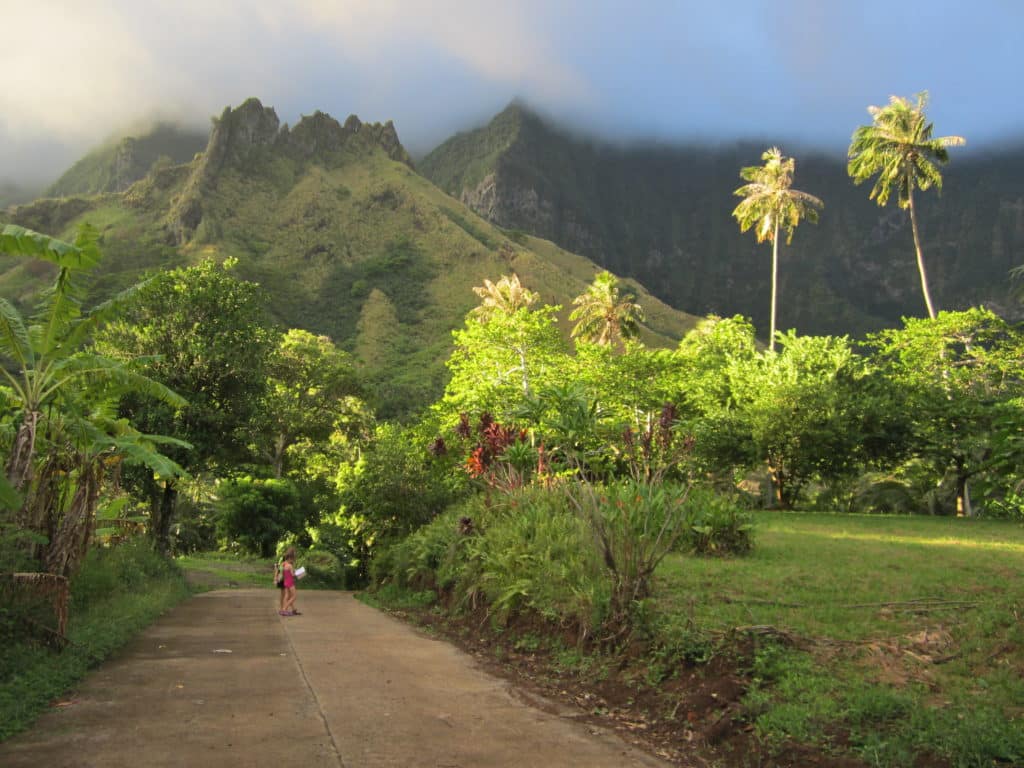
A Bustling Welcome
The outline of Hiva Oa emerged before dawn. We pulled into Taha Uku, a small harbor within Taaoa Bay, or the Bay of Traitors. At the end was a rocky, palm-fringed beach where horses grazed on shoots of grass along a freshwater stream. Just over a headland is the city of Atuona, where about 1,500 people live — a Marquesan metropolis. Behind Atuona, Mount Temetiu rises to 4,000 feet. The tight quarters and incoming swell required that we anchor bow-and-stern in the narrow cove adjacent to the supply-ship dock.
We wandered ashore on Hiva Oa, immediately feeling welcome. Right off the bat, people pulled over to give the four of us a ride into Atuona. In the tidy city hub, no larger than a city block, we found a bank where we could obtain French Pacific francs. A woman selling vegetables from her truck piled free produce onto our purchases. We strolled through a small grocery store, delighted at the selection, frightened by the prices. We checked in with the gendarmerie, passed a crêperie/Internet cafe, and met a French farmer and at last replenished the egg supply that had dwindled to nothing on our passage. Amazingly, on Fatu Hiva, wild chickens were always underfoot, but with so many other delicacies at hand, no one cared to eat them or tried to harvest their eggs.
The French painter Paul Gauguin made his home on Hiva Oa. So did the Belgian singer Jacques Brel. Both men were buried in the cemetery. We found the museum that celebrates their works and has a reproduction of Gauguin’s home. Dedicated admirers make pilgrimages here, but as this modest museum is perhaps the largest tourist-drawing element, we found few other tourist amenities. There are no big resorts, and the single airport accepts only small planes that fly in from Tahiti, 850 miles away.
In a sense, every visitor to the Marquesas is an explorer, discovering a place that is what it is, for lack of a better phrase, absent any false vibe that comes from being catered to. Later, when we reached the island of Tahuata, I asked a new friend we’d made about the meaning of the intricate tattoos that adorn the arms, legs and even faces of so many Marquesans.
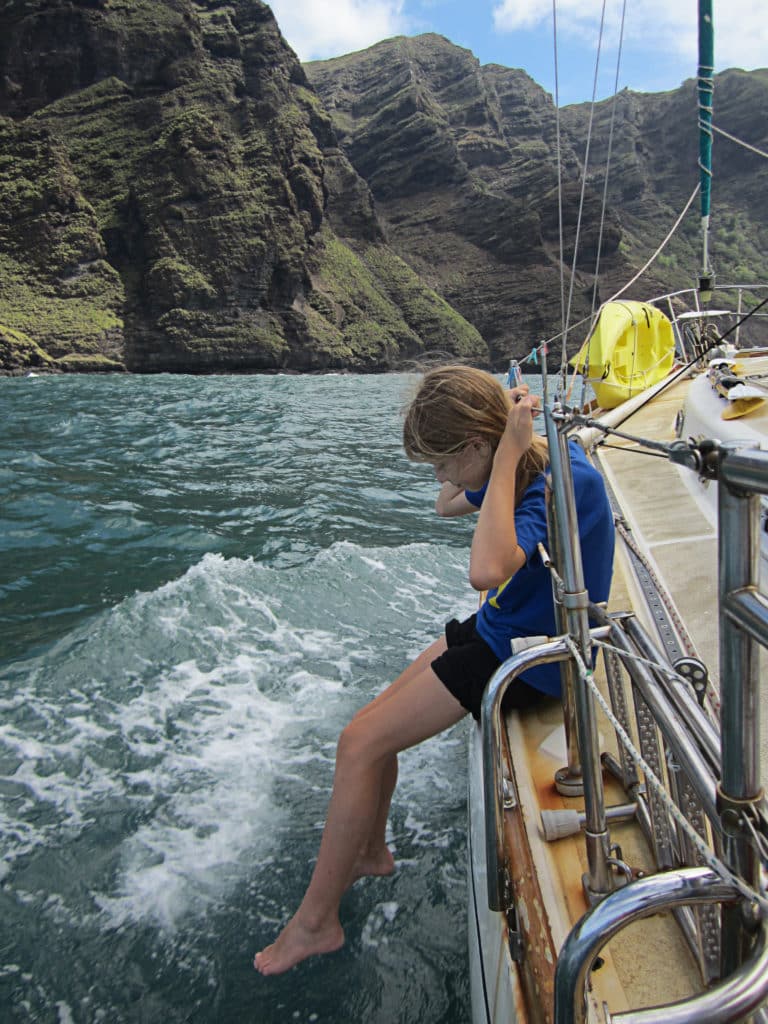
“There is none. It’s just for beauty. It’s about art and our heritage, ” he told us.
On these islands, we found that an appreciation for beauty runs deep. Women and even some men wear a gardenia or hibiscus flower behind an ear as part of their daily life. (They bloom year-round and drop from trees like leaves in a Northern Hemisphere fall.) Public spaces on every island are scrupulously clean, and art — paintings and weavings and woodcarvings — is everywhere, incorporated even into things like public benches.
There is a pride in place and culture that booms from the Marquesans I spoke with. The Marquesan people live on land that provides. More food than anyone can eat falls from trees, runs wild through the bush and swims offshore. Fresh water gushes day and night from overflowing cisterns. Perhaps it’s this bounty that somehow encourages and allows the Marquesans to keep their rich culture alive. Ahead of the annual Polynesian Heiva competitions, we saw people everywhere rehearsing for dance and music and outrigger rowing competitions. Women sat hunched over their tapas, applying ink to the pounded-out bark paper. Men carved pieces of rosewood and sandalwood by hand and with Dremels.
The Marquesan people are few in number and live on a group of islands that is not only in the middle of the Pacific, but a four-day sail from the nearest neighboring island group, the Tuamotus. They speak their own language (actually two, North Marquesan and South Marquesan); they have a history distinct from other Pacific Island groups; and for years, they’ve struggled to break free from the political chains of French Polynesia. I got the feeling that there is a conscious effort to prevent their culture from turning into a mélange of the dominant Tahitian and French influences. Say bonjour to a Marquesan, and despite the fact they’re fluent in French, you’re very apt to be corrected: ka oha.
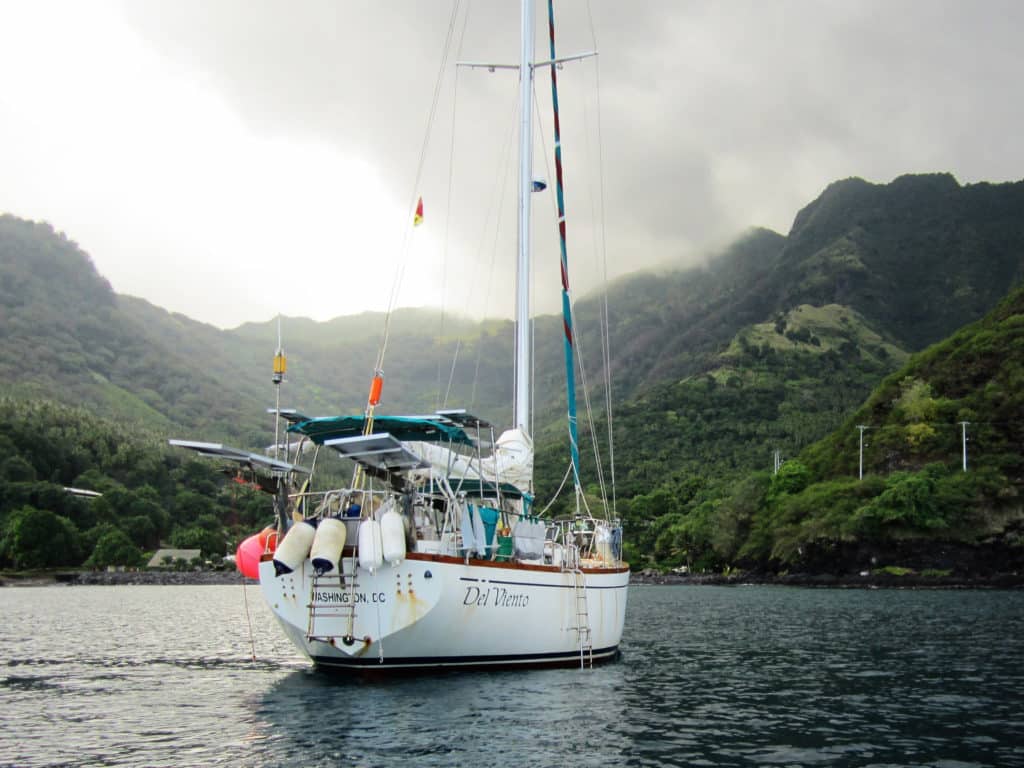
Village Life
We topped off our fuel and water before setting sail for Tahuata, a sparsely inhabited island across the 3-mile-wide Canal du Bordelais. On Tahuata, we spent our first week exploring an isolated anchorage that Eric Hiscock ranked among the three most beautiful in all of French Polynesia. Hanamoenoa Bay is home to a Marquesan known simply as Steven, who lives a hermitlike existence. He fixes visitors with an intense stare, but get on his good side and he’ll likely show you how he cultivates tomatoes just above the high-tide line and sets elaborate traps for wild pigs and chickens. Apparently fowl holds more appeal in this corner of the Marquesas.
We spent time anchored off the villages of Vaitahu and then Hapatoni, each with a stunning church and some of the most sincere, open people we’ve met in our travels. In Vaitahu we spent a couple of days getting to know Jimmy, his wife, Tahia, and their kids. They welcomed us into their home and took us on a hike to their property in an adjacent valley, where they picked tons of food and filled bags with eggplant, coconuts, mangoes, grapefruit and oranges for us to take back to the boat. Our kids and theirs hit it off, and Tahia’s English was good. Walking past the local school, she explained that it only serves children up to age 10. At 11, Marquesan kids leave home for boarding school on Nuku Hiva. Throughout the upper grades, they’re gone from home for two-month stretches, returning for two-week visits in between.
In Hapatoni, we carried ashore photos taken by a cruiser friend who visited here in the early 1970s. The daughter of the late chief gasped when she saw them, recognizing family who were no longer living, and of whom she had no photos. She showed us carvings her husband made for export to Tahitian tourist markets, and filled bags for us with fruit from her trees while her kids and ours played with a litter of puppies. We said goodbye and took off at sunset for an overnight sail to Nuku Hiva.
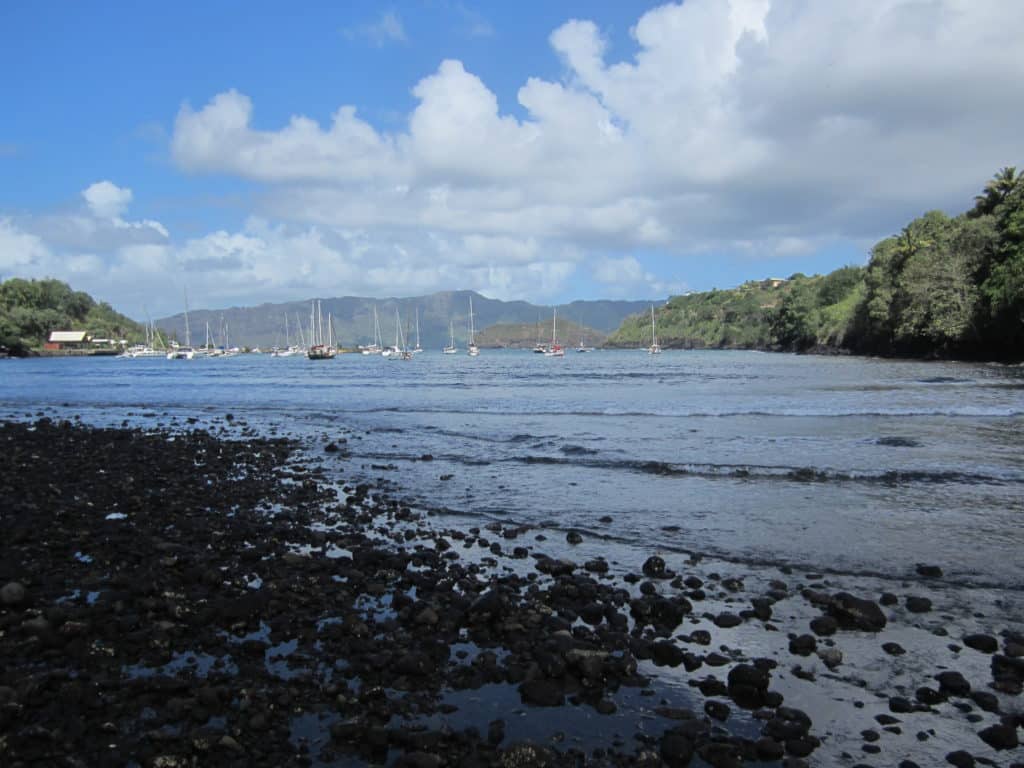
A Last Stopover
Nuku Hiva is the largest island in the Marquesas and boasts the most populous town, Taiohae, home to about 2,000 people. Taiohae sits beside a large, picturesque bay in which 100 boats could anchor. Like most Marquesan anchorages, it’s subject to a lot of roll-inducing swell. The bay is said to be contaminated with agricultural runoff, so we didn’t swim. After watching fishermen dump fish remnants into the water near the dinghy dock one morning, and witnessing the ensuing thrashing frenzy of habituated sharks, we decided it was just as well.
When our Taiohae needs were met (food, fuel, water, butane), we skirted around to nearby Taioa Bay, better known as Daniel and Antoinette’s Bay. It was to be our last anchorage in the Marquesas.
What a finale. The bay, nicknamed for a couple who were renowned friends of cruising sailors, is one of the most protected anchorages we visited in the Marquesas. Peaks and ridgelines wrap around it, staggered in their placement, exaggerating perspective and luring us ashore to travel a well-trod path along a freshwater river and up the Hakaui Valley to the falls. Daniel and Antoinette are long deceased, but family still lives in this primordial setting.
The worst thing about the Marquesas is how nature and nations conspire to keep visits brief. We left after 42 days, lamenting the fact that we didn’t have more time to spend on the five islands we visited and the 10 we skipped. We wondered about the numerous anchorages we never saw and wished for more time with the people we met. But the French enforce a 90-day visa limit for all of French Polynesia — five island groups stretched over 1,200 miles — and they make getting a visa for a longer stay difficult. The Marquesas are remote, deep in the trade winds that blow in only one direction. Once a sailor continues west, a return trip isn’t trivial.
But that’s not to say it wouldn’t be worth it. We’ll be back.
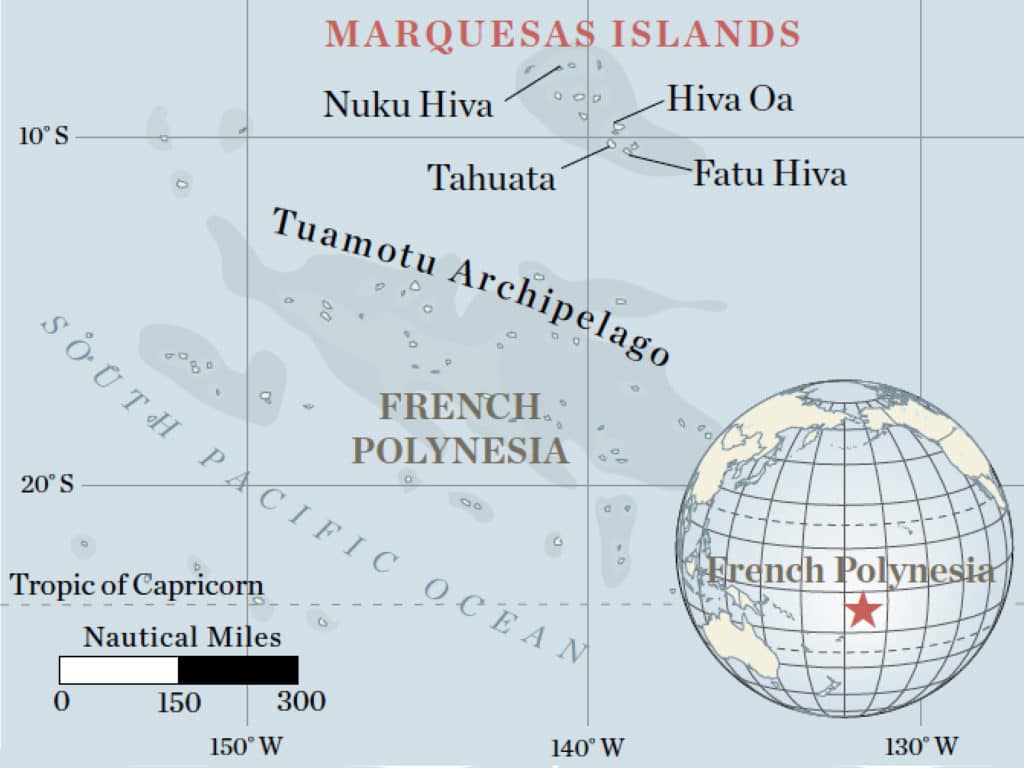
Michael Robertson is currently exploring Tonga with his family aboard their Fuji 40, Del Viento.








